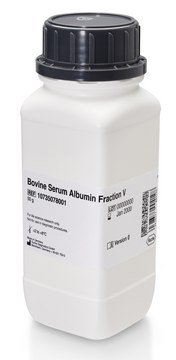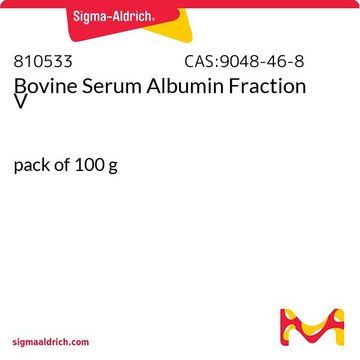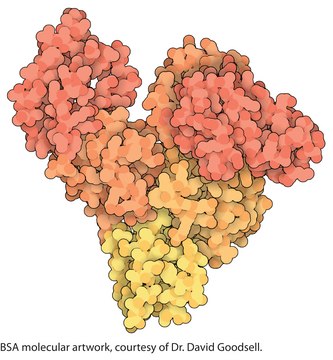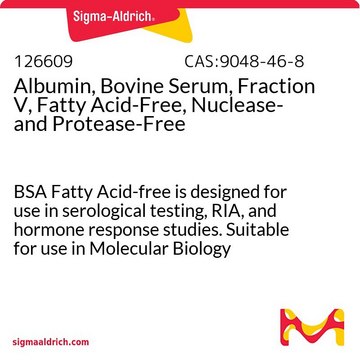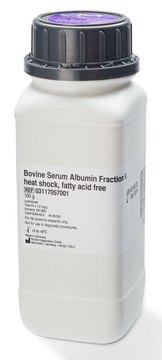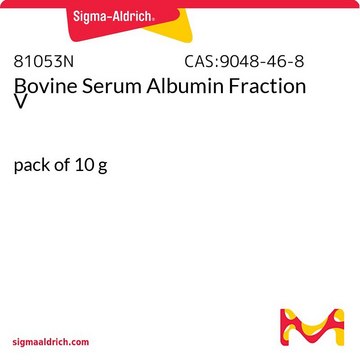03117332001
Roche
Bovine Serum Albumin Fraction V, protease-free
from bovine serum
Sign Into View Organizational & Contract Pricing
All Photos(1)
About This Item
UNSPSC Code:
12352202
NACRES:
NA.21
Recommended Products
biological source
bovine
Quality Level
Assay
≥98.5% albumin basis (electrophoresis)
form
lyophilized
packaging
pkg of 50 g
manufacturer/tradename
Roche
technique(s)
ELISA: suitable
shipped in
wet ice
storage temp.
2-8°C
General description
Bovine serum albumin (BSA) is a globular, α-helical, non-glycosylated protein is produced in the liver. It consists of three homologous, structurally different domains and two sub-domains each. BSA has 17 cysteine residues cross-linked and bound into a single chain.
Application
Bovine Serum Albumin Fraction V, protease-free is used:
- for stabilization of purified enzymes
- for site-blocking reagent in ELISA techniques
- as a protein standard for determination of protein concentration
Biochem/physiol Actions
Bovine Serum Albumin (BSA) facilitates the transmission of drugs, hormones, and fatty acids. It is the most commonly used blocking agent in enzyme-linked immunosorbent assay (ELISA). BSA enhances the differentiation of human embryonic stem cells (hESC) and is also a chief component of cell culture media.
Quality
Contaminants: ≤0.001% heavy metals; proteases not detectable (casein digest)
Other Notes
For life science research only. Not for use in diagnostic procedures.
Storage Class Code
11 - Combustible Solids
WGK
WGK 1
Flash Point(F)
Not applicable
Flash Point(C)
Not applicable
Regulatory Information
监管及禁止进口产品
Choose from one of the most recent versions:
Already Own This Product?
Find documentation for the products that you have recently purchased in the Document Library.
Amanda B Hummon et al.
BioTechniques, 42(4), 467-470 (2007-05-11)
A systems approach is being applied in many areas of the biological sciences, particularly in cancer research. The coordinated, simultaneous extraction of DNA, RNA, and proteins from a single sample is crucial for accurate correlations between genomic aberrations and their
Drew C Tilley et al.
The Journal of general physiology, 151(3), 292-315 (2018-11-07)
Allosteric ligands modulate protein activity by altering the energy landscape of conformational space in ligand-protein complexes. Here we investigate how ligand binding to a K+ channel's voltage sensor allosterically modulates opening of its K+-conductive pore. The tarantula venom peptide guangxitoxin-1E
Jon T Sack et al.
The Journal of general physiology, 142(3), 315-324 (2013-08-14)
A family of 40 mammalian voltage-gated potassium (Kv) channels control membrane excitability in electrically excitable cells. The contribution of individual Kv channel types to electrophysiological signaling has been difficult to assign, as few selective inhibitors exist for individual Kv subunits.
Docosahexaenoic acid prevents palmitate-induced activation of proteolytic systems in C2C12 myotubes.
Myra E Woodworth-Hobbs et al.
The Journal of nutritional biochemistry, 25(8), 868-874 (2014-05-20)
Saturated fatty acids like palmitate contribute to muscle atrophy in a number of conditions (e.g., type II diabetes) by altering insulin signaling. Akt is a key modulator of protein balance that inhibits the FoxO transcription factors (e.g., FoxO3) which selectively
Glennys V Reynoso et al.
Methods in molecular biology (Clifton, N.J.), 2023, 287-299 (2019-06-27)
This chapter provides methods for the propagation, purification, and titration of vaccinia virus (VACV) and the highly attenuated strain-modified vaccinia Ankara (MVA). Additionally, we provide information on VACV recombinants we have used for intravital imaging with multiphoton excitation.
Our team of scientists has experience in all areas of research including Life Science, Material Science, Chemical Synthesis, Chromatography, Analytical and many others.
Contact Technical Service